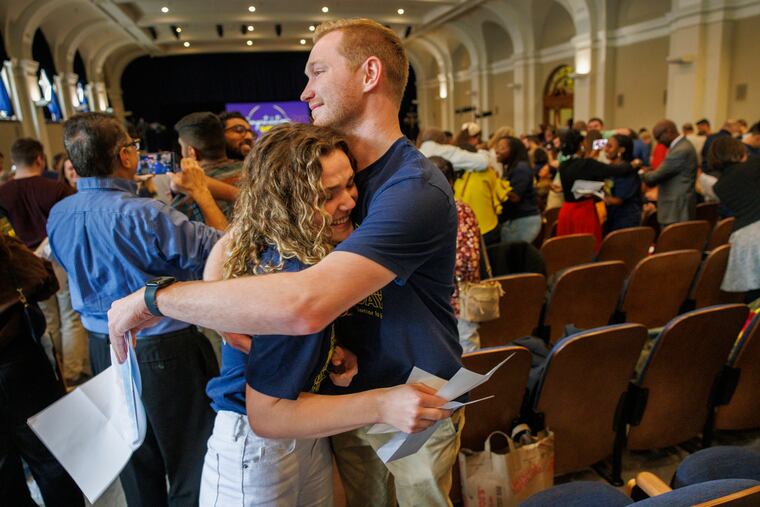Two Drexel medical students had matched for romance. But could they make a match for residency training?
The National Resident Matching Program pairs medical students with the hospitals where they will spend their first years as doctors.

Soon-to-be newly minted doctors Jannah Wing and Kevin Rooney, who have been dating since their first year at Drexel University College of Medicine, knew they wanted to spend the next phase of their training together when it came time to apply for medical residency programs.
They knew, too, that they were signing up for a uniquely stressful phase in both their education and their relationship. The residency match process — where medical students apply to hospitals to spend their three-year training period after medical school — is grueling on its own. But for couples who hope to do their residency in the same place, it’s doubly so.
Friday was the moment of truth, for Wing, Rooney, and thousands of others — Match Day, when students would find out which hospital selected them.
Over a period of several months, hospitals interview prospective residents from around the country, selecting a pool of candidates. Meanwhile, students rank the programs they’d most like to join. Couples in the process “pair” their rankings, judging a program not just by its suitability for them but for its proximity to their partner’s top choices.
To cast a wide net, “we applied to a lot more programs and interviewed at more programs than most people would,” Wing said. “There’s a lot of give and take — there were a couple programs which I really liked, but then Kevin didn’t have any programs he liked in that location.”
Some of their options involved completing residency at different hospitals in the same city. In other scenarios, they’d be a few hours apart. But their top choice was to work together at Yale University’s health system in Connecticut, where Rooney hoped to complete a residency in anesthesiology and Wing would focus on diagnostic and interventional radiology.
On Friday, Wing, Rooney, and their parents took their seats in an auditorium on Drexel’s campus with their graduating class to learn where they’d spend the next three years.
“Even if it isn’t Yale, we’re sure it’s going to be a good day. We matched — and that’s 95% of the battle right there,” Rooney said.
A high match rate for a large med school class
Both Rooney, who’s from Albany, N.Y., and Wing, who grew up in Bethlehem, Pa., have wanted to become doctors for as long as they can remember.
They met at a socially distanced mixer for new medical students in their first year, and quickly hit it off. Wing was drawn to Rooney’s steady presence; Rooney liked how she could make him laugh. “Anytime our friend group was getting together, everyone was wondering where Jannah was. She’s the life of the party, and smart and gorgeous, too,” he said.
They opted to complete their clinical rotations in their third and fourth years of medical school together, in the San Francisco Bay Area. Drexel’s teaching hospital, Hahnemann Hospital, closed in 2019, and the school now partners with several hospitals around the country to send students on clinical rotations.
Charles Cairns, the dean of Drexel’s medical school, said such partnerships allow students to gain a wide variety of experience around the country even before residency.
“They’re connected with both communities and the health systems. The partnership is critical — and it manifests itself in the match rate,” he told The Inquirer.
Every student in the class seeking to match with a residency program did so, he said, and this year’s class of more than 250 is the largest of his tenure.
Counting down to a match
In the auditorium, Rooney, Wing, and their parents listened as school officials read off statistics about where members of the class had matched. Just six were going to programs in Connecticut. The couple tried not to think about what that meant for their odds.
Finally, officials passed out envelopes with their match papers inside. The projector screen on the stage of the auditorium counted down from 10. Rooney pressed a kiss to Wing’s forehead. Then, together, they opened the envelopes.
“Oh, my God,” Wing gasped, turning to Rooney. “We did it!”
The two had both matched at Yale.
As their parents wiped away tears, the couple hugged friends and tried to let the moment sink in.
“It feels surreal,” Rooney said. “To go through this 10-year journey, with all the ups and downs, all to end up at your top choice with your best friend.”
Their perfect match was hard to believe. “We have to double-check these papers,” Wing said, laughing.